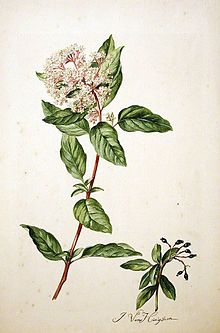Viburnum tinus
| Viburnum tinus | |
|---|---|

| |
| By L. By Jacob van Huysum | |
| Scientific classification | |
| Kingdom: | Plantae |
| Clade: | Tracheophytes |
| Clade: | Angiosperms |
| Clade: | Eudicots |
| Clade: | Asterids |
| Order: | Dipsacales |
| Family: | Adoxaceae |
| Genus: | Viburnum |
| Species: | V. tinus
|
| Binomial name | |
| Viburnum tinus | |
| Synonyms | |
| |
Viburnum tinus, the laurustinus, laurustine or laurestine, is a species of
Description

It is a shrub (rarely a small tree) reaching 2–7 m (7–23 ft) tall and 3 m (10 ft) broad,[1] with a dense, rounded crown. The leaves are evergreen, persisting 2–3 years, ovate to elliptic, borne in opposite pairs, 4–10 cm long and 2–4 cm broad, fine hairs persisting on the underside, with an entire margin.
The flowers are small, white or light pink, produced from reddish-pink buds in dense
The leaves have domatia where predatory and microbivorous mites can be housed.[3]
Distribution and habitat
Native to the
Cultivation
Viburnum tinus is widely cultivated for its winter blooms and metallic blue berries. It is hardy down to −10 °C (14 °F). The cultivars 'Eve Price',[6] 'French White'[7] and 'Gwenllian'[8] have gained the Royal Horticultural Society's Award of Garden Merit.[9]
Other uses
V. tinus has been used for its traditional medicinal properties, for example in Pakistan.[citation needed] The active ingredients are viburnin (a substance or more probably a mixture of compounds) and tannins. Tannins can cause stomach upset. The leaves when infused are said to have antipyretic properties. The fruits have been used as purgatives against constipation. The tincture has been used lately in herbal medicine as a remedy for depression. The plant also contains iridoid glucosides.[10]
Pests
In south-east Britain Viburnum tinus is the principal host of the viburnum beetle (
Etymology
The
References
- ISBN 978-1405332965.
- ^ Hartley, Charlotte (2020-08-06). "The secret to this fruit's mysterious blue color". Science | AAAS. Retrieved 2020-08-07.
- IUCN. November 2017. Retrieved 8 December 2020.
- ^ "Viburnum tinus L." Catalogue of Life. Retrieved 8 December 2020.
- ^ "RHS Plantfinder - Viburnum tinus 'Eve Price'". Retrieved 18 February 2019.
- ^ "RHS Plantfinder - Viburnum tinus 'French White'". Retrieved 18 February 2019.
- ^ "RHS Plantfinder - Viburnum tinus 'Gwenllian'". Retrieved 18 February 2019.
- ^ "AGM Plants - Ornamental" (PDF). Royal Horticultural Society. July 2017. p. 107. Retrieved 18 February 2019.
- ^ "Top 10 pests". Wisley, England: Royal Horticultural Society. 19 January 2011. Archived from the original on October 9, 2013. Retrieved 10 May 2011.
- Perseus Project.
- Perseus Project.
External links
- Flora Europaea: Viburnum tinus
- Eriksson, O., et al. 1979. Flora of Macaronesia: checklist of vascular plants
- Pignatti S. - Flora d'Italia – Edagricole – 1982, Vol. II, pag. 639
- Biolib
- Viburnum tinus
Gallery
-
Plant
-
Inflorescence
-
Close-up on flowers
-
Unripe fruits
-
Ripe fruits
-
Close-up on fruits
-
Leaf








